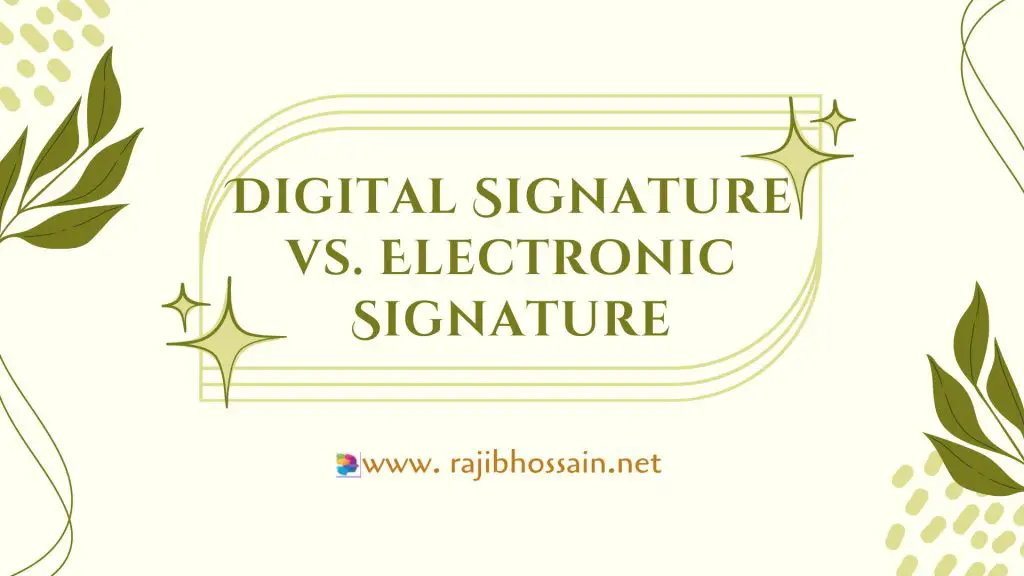
Introduction
In the realm of digital transactions, understanding the distinction between digital signatures and electronic signatures is crucial. Both play a significant role in securing electronic documents and ensuring their authenticity, but they operate differently and are used in various contexts. This article will explore the differences between digital and electronic signatures, their applications, and the benefits they offer.
What is an Electronic Signature?
An electronic signature (e-signature) is any electronic indication of a person’s intent to agree to the contents of a document. It can be as simple as typing your name at the end of an email, clicking an “I Agree” button, or using a stylus to draw your signature on a touchscreen.
Key Features of Electronic Signatures
- Simplicity: Easy to use and implement across various platforms and devices.
- Versatility: Can be used for a wide range of documents and transactions, from informal agreements to formal contracts.
- Legally Binding: Recognized as legally binding in many jurisdictions, provided certain conditions are met.
Common Uses of Electronic Signatures
- Contract Agreements: Signing contracts and agreements quickly and efficiently.
- Acknowledgments: Approving terms and conditions or receiving consent.
- Internal Approvals: Streamlining internal business processes and approvals.

Best eSignature service
What is a Digital Signature?
A digital signature is a specific type of electronic signature that uses cryptographic technology to secure and validate the authenticity of a document. Digital signatures are created using a digital certificate issued by a Certificate Authority (CA).
Key Features of Digital Signatures
- Cryptographic Security: Uses public key infrastructure (PKI) to encrypt and authenticate the signature.
- Verification: Provides a method to verify the signer’s identity and the integrity of the signed document.
- Tamper-Proof: Any alterations to the document after signing will invalidate the signature, ensuring the document’s integrity.
Common Uses of Digital Signatures
- Financial Transactions: Ensuring the security and authenticity of high-value financial transactions.
- Legal Documents: Signing legal documents that require a high level of security and assurance.
- Healthcare Records: Securing sensitive medical records and patient information.
Key Differences Between Digital and Electronic Signatures
1. Technology
- Electronic Signature: This can be as simple as a typed name or a scanned image of a handwritten signature. Does not necessarily use cryptographic technology.
- Digital Signature: Uses cryptographic algorithms and digital certificates to secure the signature and verify the signer’s identity.
2. Security
- Electronic Signature: Varies in security based on the method used. Some methods offer minimal security, while others, like biometric signatures, provide higher security.
- Digital Signature: Offers higher security through encryption, ensuring the document’s integrity and the signer’s identity.
3. Legal Validity
- Electronic Signature: Legally binding in many jurisdictions, but the level of legal assurance can vary.
- Digital Signature: Often meets higher standards for legal validity and compliance, especially in regulated industries.
4. Verification
- Electronic Signature: This may require additional verification methods, such as email verification or SMS codes.
- Digital Signature: Verification is built into the signing process through digital certificates and public key infrastructure (PKI).
5. Usage Context
- Electronic Signature: Suitable for everyday transactions where security and authentication are not critical.
- Digital Signature: Used in scenarios requiring high security and assurance, such as financial, legal, and healthcare applications.
Benefits of Electronic and Digital Signatures
Benefits of Electronic Signatures
- Convenience: Easy to use and implement, allowing for quick signing of documents.
- Cost-Effective: Reduces the need for paper, printing, and postage costs.
- Improved Workflow: Streamlines business processes by enabling fast and efficient document signing.

Best eSignature service
Benefits of Digital Signatures
- Enhanced Security: Provides high levels of security through encryption and verification.
- Legal Assurance: Meets stringent legal and regulatory requirements, ensuring the authenticity and integrity of signed documents.
- Tamper-Proof: Ensures that any changes to the document after signing will invalidate the signature, protecting the document’s integrity.
Choosing Between Electronic and Digital Signatures
When deciding whether to use an electronic or digital signature, consider the following factors:
- Security Needs: If the transaction requires high security and verification, a digital signature is the better choice.
- Legal Requirements: For legally binding documents, especially in regulated industries, a digital signature may be necessary to meet compliance standards.
- Convenience and Speed: For everyday transactions and internal approvals, an electronic signature is often sufficient and more convenient.
- Cost Considerations: Electronic signatures are generally more cost-effective, while digital signatures may involve additional costs for digital certificates and infrastructure.
Conclusion
Both digital and electronic signatures play crucial roles in modern digital transactions, offering distinct benefits and applications. Understanding the differences between them helps businesses and individuals choose the right type of signature for their needs. Whether you need the simplicity and convenience of an electronic signature or the enhanced security and legal assurance of a digital signature, both options provide valuable tools for securing and authenticating electronic documents in today’s digital world.
